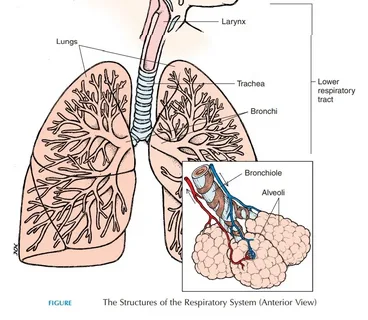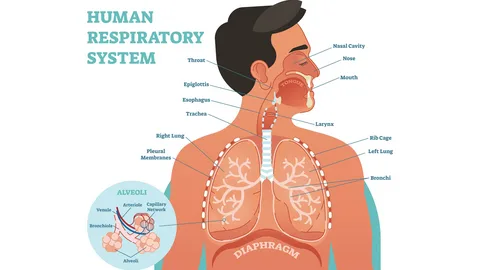The respiratory system is one of the most vital systems in the human body. It is responsible for one of the most important life functions—breathing. Every living human needs oxygen to stay alive, and the respiratory system ensures that oxygen reaches every cell of our body. It also helps remove a harmful gas called carbon dioxide, which is a waste product of the energy-making process in our cells.
Even though breathing feels automatic, there is a complex process going on inside us. Our respiratory system works day and night, even when we are asleep. In this blog, we will explore the parts, functions, working, diseases, care, and importance of the respiratory system in great detail.
Importance of the Respiratory System
The respiratory system performs several vital functions for the body. Some of its most important roles include:
- Oxygen supply: It brings oxygen from the air into the bloodstream.
- Carbon dioxide removal: It removes carbon dioxide from the blood.
- Speech and sound: It helps in producing voice and sounds.
- Smell: It is involved in the sense of smell.
- Protection: It traps harmful particles and defends against infections.
- Helps maintain pH: It balances the levels of acids and bases in the body.
Without oxygen, human brain cells start dying in just five minutes. That’s how crucial the respiratory system is to life.
Parts of the Respiratory System
The respiratory system is made up of many parts. These can be grouped into two sections: the upper respiratory tract and the lower respiratory tract.
Upper Respiratory Tract
The upper part of the respiratory system includes:
1. Nose and Nasal Cavity
- Air enters the respiratory system through the nose.
- Tiny hairs called cilia and sticky mucus trap dust, germs, and dirt.
- The air is warmed and moistened before it goes to the lungs.
2. Mouth
- The mouth is also a passage for air, especially when we breathe heavily.
- It lacks the filters and warming functions of the nose but still helps.
3. Pharynx (Throat)
- The pharynx is a shared space for both food and air.
- Air passes from the nose/mouth to the trachea through the pharynx.
4. Larynx (Voice Box)
- Located just below the pharynx.
- It contains the vocal cords, which vibrate to produce sound.
- It also stops food from entering the windpipe during swallowing.
Lower Respiratory Tract
The lower part of the respiratory system includes:
5. Trachea (Windpipe)
- A long, stiff tube that connects the throat to the lungs.
- Supported by C-shaped cartilage rings to keep it open.
- It carries air to the lungs.
6. Bronchi
- The trachea splits into two tubes called bronchi, one for each lung.
- These lead air deeper into the lungs.
7. Bronchioles
- The bronchi branch into smaller tubes called bronchioles.
- They spread like tree branches inside the lungs and carry air to the alveoli.
8. Alveoli
- Tiny balloon-like sacs where gas exchange takes place.
- There are over 300 million alveoli in the lungs.
- Oxygen passes from the alveoli into the blood, and carbon dioxide moves from the blood into the alveoli.
9. Lungs
- The lungs are the main organs of the respiratory system.
- The right lung has three lobes, and the left has two lobes (to make space for the heart).
- The lungs are surrounded by a thin protective layer called the pleura.
10. Diaphragm
- A dome-shaped muscle located below the lungs.
- It helps pump air in and out of the lungs.
- When it contracts, it creates space in the lungs for air to enter.

How the Respiratory System Works
The respiratory system works in a cycle of inhalation and exhalation. Let’s explore how this process works step by step:
Step 1: Inhalation
- You breathe in through your nose or mouth.
- The air passes through the nasal cavity, pharynx, larynx, and trachea.
- It travels down the bronchi and bronchioles into the alveoli.
Step 2: Gas Exchange
- Inside the alveoli, oxygen moves into the capillaries (tiny blood vessels).
- At the same time, carbon dioxide moves out of the blood into the alveoli.
Step 3: Transport by Blood
- Oxygen-rich blood is carried to the heart.
- The heart pumps it to every cell in the body through arteries.
- Carbon dioxide-rich blood returns from the body to the lungs through veins.
Step 4: Exhalation
- The diaphragm relaxes and moves upward.
- This pushes the air out of the lungs through the same pathway (bronchi to trachea to mouth/nose).
- The air we breathe out contains carbon dioxide and water vapor.
Working with Other Body Systems
The respiratory system does not work alone. It closely works with:
1. Circulatory System
- The blood carries oxygen from the lungs to the body and brings carbon dioxide back to the lungs.
- Hemoglobin in red blood cells binds with oxygen for transport.
2. Nervous System
- The brain controls breathing automatically.
- It senses the level of carbon dioxide in the blood and tells the lungs when to breathe faster or slower.
3. Muscular System
- Muscles like the diaphragm and intercostal muscles help with breathing movements.
Common Respiratory Diseases and Conditions
Even though the respiratory system is strong, it can be affected by many diseases.
1. Asthma
- A chronic disease where airways become narrow and inflamed.
- Causes coughing, wheezing, and shortness of breath.
- Triggered by allergens, smoke, or exercise.
2. Bronchitis
- Inflammation of the bronchi.
- Often caused by infection or smoking.
- Symptoms include coughing with mucus and chest discomfort.
3. Pneumonia
- Infection that causes fluid to fill the alveoli.
- Can be caused by bacteria, viruses, or fungi.
- Can make breathing very hard and dangerous if untreated.
4. Chronic Obstructive Pulmonary Disease (COPD)
- A group of lung diseases like chronic bronchitis and emphysema.
- Often caused by long-term smoking or pollution exposure.
- Makes breathing slowly worse over time.
5. Tuberculosis (TB)
- Caused by bacteria that attack the lungs.
- A contagious disease spread through coughing and sneezing.
6. Lung Cancer
- Abnormal growth of cells in the lungs.
- One of the most dangerous respiratory system diseases.
- Mainly caused by smoking or long-term exposure to harmful chemicals.
How to Keep the Respiratory System Healthy
Taking care of your respiratory system is important for a long and healthy life. Here’s how:
- Don’t smoke: Smoking damages the lungs and causes many diseases.
- Avoid secondhand smoke and polluted air.
- Exercise regularly to keep your lungs strong.
- Eat a balanced diet with fruits and vegetables.
- Stay hydrated to keep the airways moist.
- Get vaccinated against diseases like flu and pneumonia.
- Wash hands regularly to avoid infections.
- Breathe through the nose, not the mouth, to filter and warm air.
- Practice deep breathing exercises to improve lung capacity.
Fun and Surprising Facts About the Respiratory System
- On average, a person takes about 20,000 breaths every day.
- Your left lung is smaller than the right one to make room for your heart.
- If all the alveoli in your lungs were spread out, they would cover the size of a tennis court.
- The lungs are the only organs in the body that can float on water.
- Coughing is a protective reflex to clear your airways.
Conclusion: Why You Should Understand the Respiratory System
Understanding the respiratory system helps us appreciate the complex and life-saving processes that happen every moment in our body. This system plays a central role in keeping us alive, active, and healthy. It brings in the oxygen our cells need and removes waste gases that could harm us.
Whether you are a student trying to learn about how your body works, or an adult curious about health, knowing how the respiratory system works can help you take better care of yourself and others.
FAQs About the Respiratory System
What is the main function of the respiratory system?
The main function of the respiratory system is to bring oxygen into the body and remove carbon dioxide.
What organs are part of the respiratory system?
The respiratory system includes the nose, pharynx, larynx, trachea, bronchi, bronchioles, lungs, alveoli, and diaphragm.
How does breathing work?
Breathing involves inhaling air through the nose or mouth, where it travels through the respiratory tract to the lungs, and exhaling carbon dioxide after gas exchange.
What are alveoli?
Alveoli are tiny air sacs in the lungs where oxygen enters the blood and carbon dioxide is removed.
How can I improve my respiratory health?
Avoid smoking, stay away from pollution, exercise regularly, eat healthy, and practice deep breathing.












